By Lori Stultz, VO Rocky Mountain Outreach Coordinator
Check out David Carter, The 300 Pound Vegan, as he enjoys a Follow Your Heart breakfast quiche in bed! This clip will certainly bring a smile to your face.
By Lori Stultz, VO Rocky Mountain Outreach Coordinator
Check out David Carter, The 300 Pound Vegan, as he enjoys a Follow Your Heart breakfast quiche in bed! This clip will certainly bring a smile to your face.
By Lori Stultz, VO Rocky Mountain Outreach Coordinator

Keeping with the theme of breakfast—thanks, David!—today we’re serving up pancakes!
But not just any kind of pancakes—pumpkin pancakes!
If you’re mourning the end of summer like me, this recipe will help ease the change of seasons.
And if you’re happily embracing the shifting temperatures and fall-like flavors popping up in almost every kind of food you can imagine, then you’re probably going to love this recipe!
Pumpkin Pancakes
Serves about 3-4.
Ingredients
Directions
Recipe Tips/Variations
This original recipe can be found on Connoisseurs Veg.
By Lisa Rimmert, VO Director of Development

I don’t consider myself a sentimental person, but boy do I love a good wedding. What’s even better? A vegan wedding!
On May 21, 2016, VO donor and volunteer, Corinna Fish, celebrated a vegan and green wedding with her now-husband Chad Stockdale in Sacramento, CA. We asked Corinna to tell us about it, and I think you’ll love how they incorporated VO into their special day. We certainly did!
Lisa Rimmert: Tell us about yourself, Corinna.
Corinna Fish: I’m a proposal writer for the University of California – Davis. When my hands aren’t typing, they’re pressed against my yoga mat or crafting—I love crochet, embroidery, and paper crafts.
Lisa: How did you become involved in animal protection?
Corinna: My best friend became vegan when we were teenagers, and in my early twenties I had a vegan roommate who was an incredible chef and baker. I didn’t know how to cook at all, so I lucked out in that she helped me with my first vegan cooking attempts, and everything she made turned out delicious. She also had a lot of animal rights literature, including Vegan Outreach booklets, that influenced me.
To be honest I’m only vegan when it comes to grocery shopping and cooking at home—I’m still flexitarian at family holiday gatherings and when I’m dining out with friends or coworkers. But part of the reason I support VO is because its work made me realize I can still help animals even if I’m not a perfect vegan. And staying involved with VO inspires me to keep striving toward a completely cruelty-free diet.
Lisa: How did you first get involved with VO and what inspires you to donate and volunteer?
Corinna: In my early twenties I struggled with wanting to be 100% vegan and activism burnout. Around 2004 I read most of what VO had published up to that point and the essays were a huge influence on me, especially the ones about working toward a vegan world instead of a vegan club and making the movement as effective as possible. I appreciated the transparency and solid analysis behind choosing to focus on leafleting, and I really trust that my donation dollars are having the maximum impact on ending animal suffering.
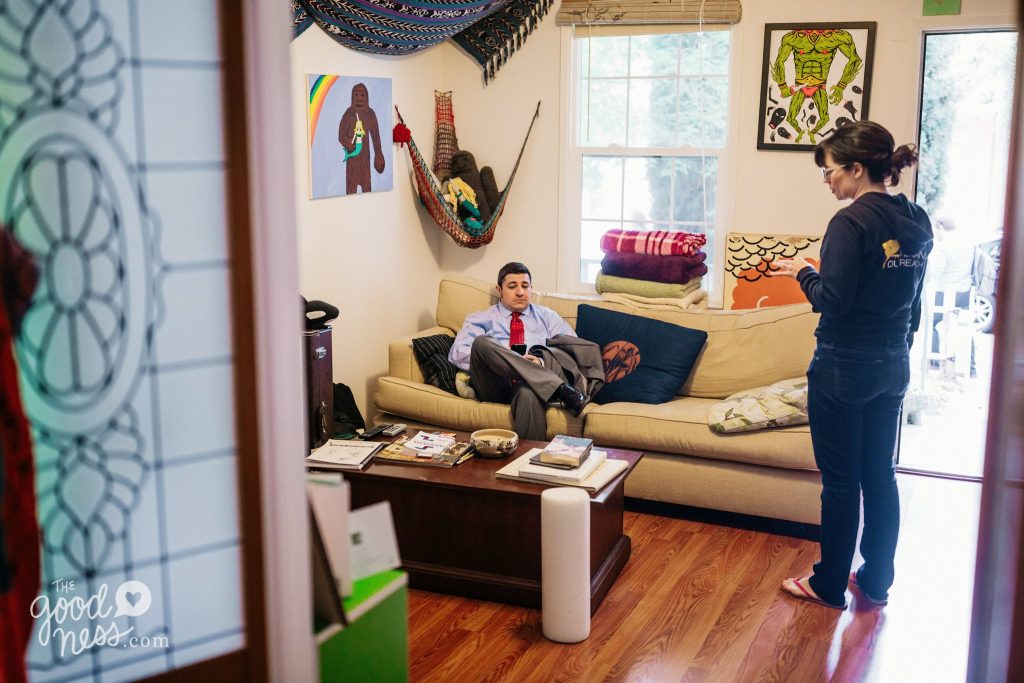
Lisa: You got married this summer. Congratulations! Will you tell us why and how you incorporated VO into your special day? What did your guests think?
Corinna: It was important to Chad and me to have a green wedding, so we looked into purchasing carbon offsets. But after some research we decided they weren’t very effective. So we used a carbon footprint calculator, which also provides a suggested offset cost, and donated that amount to Vegan Outreach instead. We included a short explanation of why we did that on our wedding website, along with a link to VO’s Diet and Global Warming article.
We also displayed a small sign near the guestbook to let guests know we made donations to Vegan Outreach and another animal organization we support. That sign hangs in our house now and is one of our favorite keepsakes from that day.
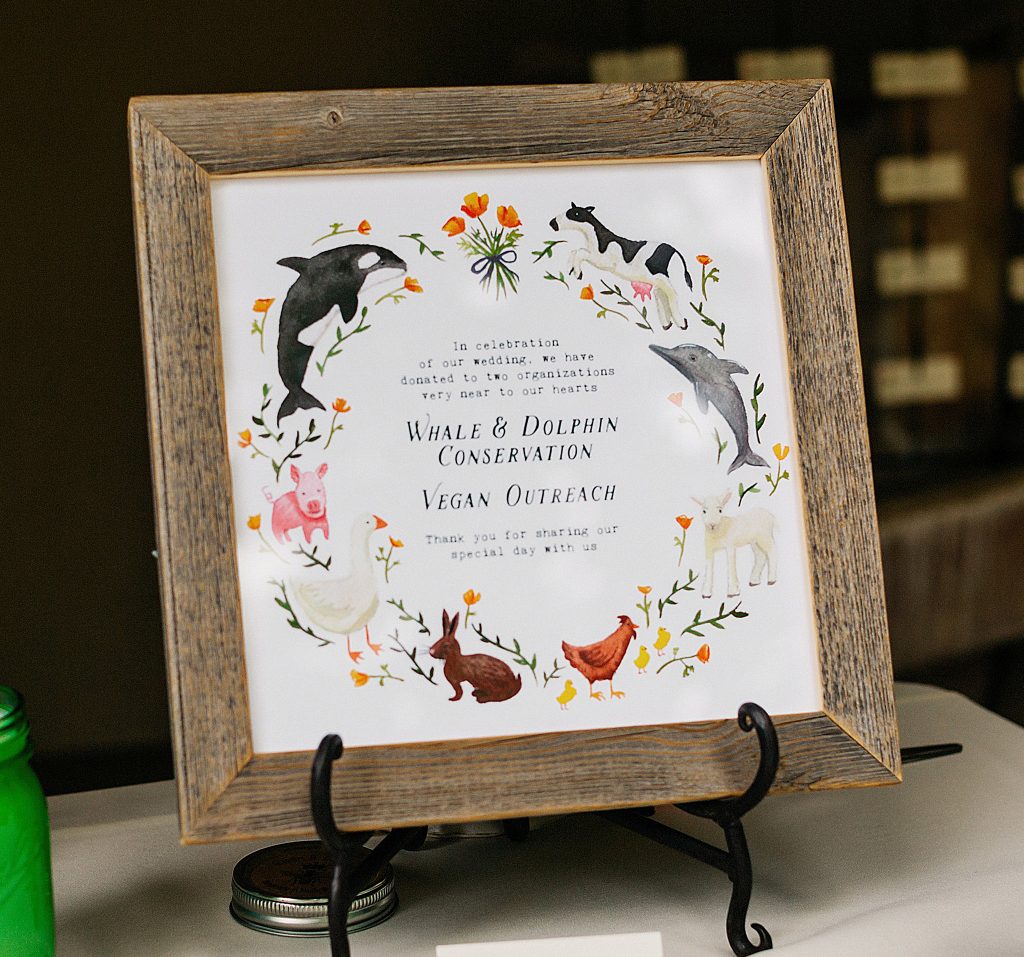
Lisa: How was it planning a vegan wedding? How did guests respond?
Corinna: We are lucky enough to know Joshua Ploeg—the Touring Vegan Chef and author of many cookbooks including In Search of the Lost Taste—and we both adore his cooking, so it was an easy decision to hire him.
I did read wedding planning forums where there was a passionate consensus against serving vegan food to non-vegan guests, but it seemed like the primary concern was the common perception that vegan food is flavorless. So I think the key is to make the quality of the food a priority. Top shelf alcohol helps too!
We specified on our invitations and wedding website that there would be a vegan buffet. Nobody asked about it before the wedding and as far as we know everyone was happy. Many omnivores commented on how good the food was, including a die-hard carnivore uncle.
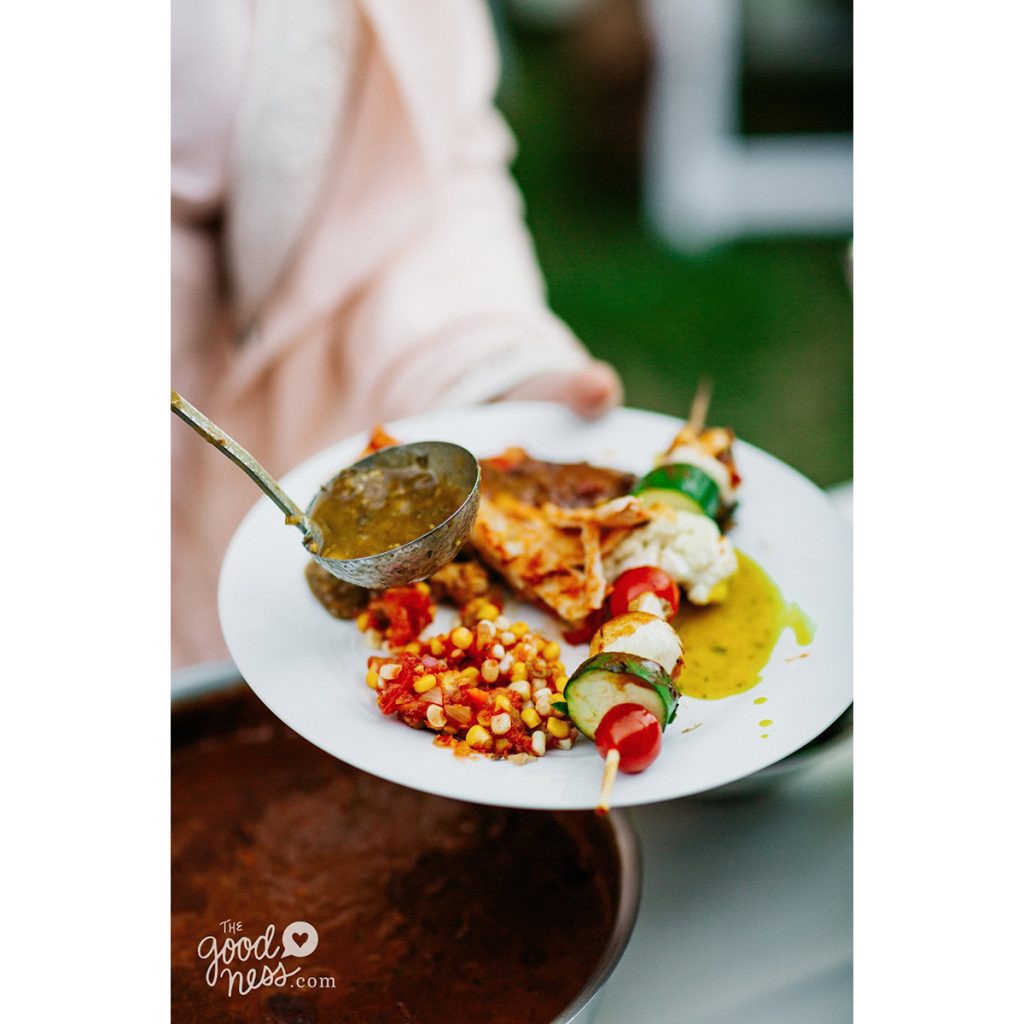
Lisa: What is your favorite vegan meal to eat with your new spouse?
Corinna: Our favorite quick-and-easy meal is soyrizo and spinach in a tortilla. When we want something fancy and have the time, we love Pumpkin Baked Ziti with Caramelized Onions and Sage Crumb Topping from Veganomicon. I don’t think we’ve ever tried a recipe by Isa Chandra Moskowitz that we didn’t like!
Lisa: Thank you, Corinna, and congratulations to you and Chad!
Photos: © The Goodness

Join Vegan Soul, Vegan Outreach, VO’s David Carter—The 300 Pound Vegan—and a ton of great vendors and speakers for the 3rd Annual Vegan Soul Wellness Festival in Oakland, CA. This free event will take place at Laney College on Saturday, September 24.
See you there!
By Lori Stultz, VO Rocky Mountain Outreach Coordinator
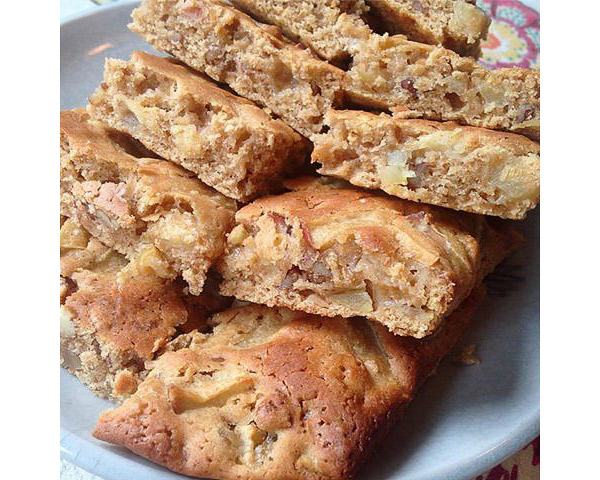
With fall right around the corner, Renee Press’—with Fire and Earth Kitchen—Apple Pie Bars seemed like a very seasonally fitting recipe to share.
I haven’t personally made or tasted these bars, but given Renee’s very positive track record of offering this blog various delicious recipes, I’ve no doubt this one also will be fantastic.
If you decide to give this recipe a try, please take a few moments to comment after you’ve made them! I’d love to hear about the end result!
Apple Pie Bars
Yields 12-16 bars.
Ingredients
Directions
Recipe Tips/Variations
By Katia Rodríguez, Mexico Campaigns and Spanish Media Coordinator
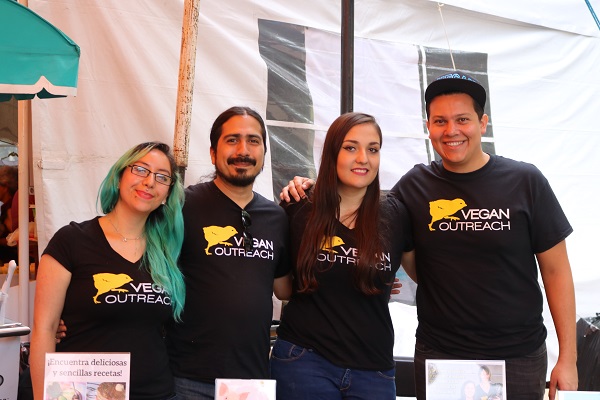
About a month ago, Emmanuel Márquez—VO’s Mexico Outreach Coordinator—and I were invited to a small vegfest called “Bazar la Veganería” held in a public park in Mexico City, Mexico.
Originally, our Mexico City volunteers were going to be in charge of setting up the VO table, but luckily Emmanuel and I were nearby—in the Mexican state of San Luis Potosí—finishing a week of leafleting. So we decided to drive to Mexico City to join them for the weekend before heading to another Mexican state to leaflet.


While Emmanuel drove us to Mexico City, I took that time to send out some emails to our vegan mentors in Mexico City. We told them that we’d soon be visiting the area and would love to meet with them. Emmanuel and I wanted to get to know them, hear about their experiences of being mentors, and see if they had any suggestions for how we can improve the mentor program.
Four Spanish vegan mentors in Mexico City—Carla Ríos, Claudia Zamora, Jessica Hernández, and Martha Castillo—came to see us while we were there in town. We could hardly contain our excitement after talking with them and hearing all of their positive feedback. They told us how excited and happy they are to be helping other people achieve their goal of consuming less animal food products. We can’t wait to return to Mexico City someday to meet up with these star mentors again!

Then, at the Bazar la Veganería vegfest, we set up a table with leaflets, stickers, pins, and VO shirts. We were so happy with the response—our table was constantly busy. The leaflet take rate was great, and some people even asked if they could take leaflets to share with their family and friends. You could see our leaflets everywhere you looked around. We also had a lot of people stopping by to ask about our Spanish Vegan Mentor Program, and the Spanish section of the VO website.


I should mention that this was my first time visiting Mexico City, so I was really excited to do outreach and try all of the amazing vegan food the city has to offer.
During the vegfest event, there was a lot of delicious vegan food being sold—including ice cream, chocolates, traditional Mexican food, desserts, and other handmade products.
This is what being vegan in Mexico City looks like!


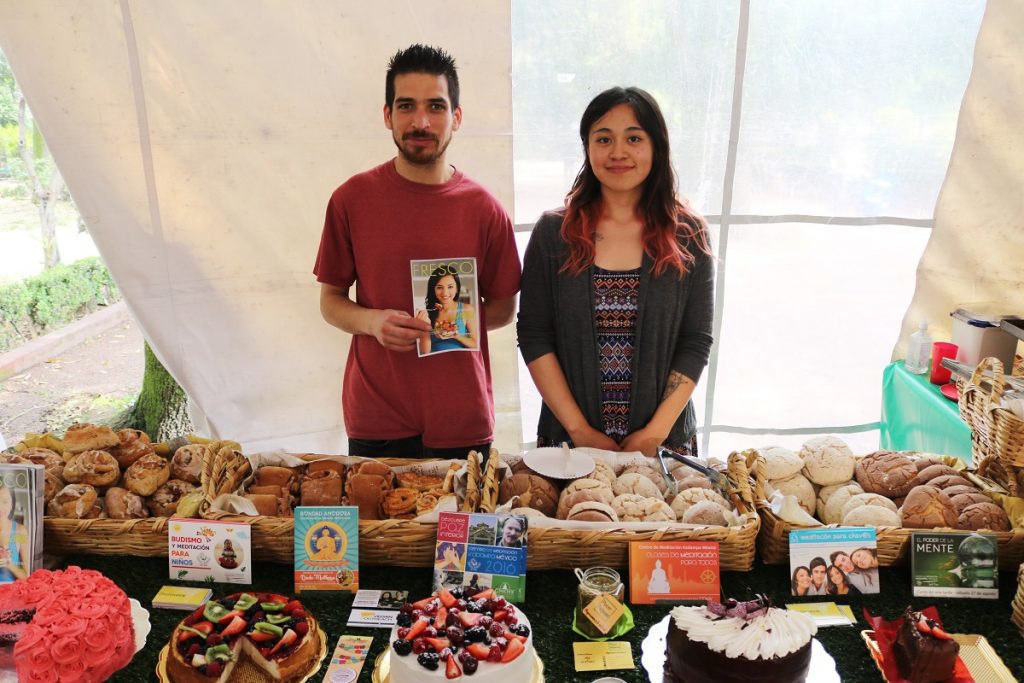
Can you tell I loved my first time in Mexico City!
I can’t wait to share more with you about what it’s like being vegan in Mexico!
By Lisa Rimmert, VO Director of Development
Last month, over 300 VO supporters ordered this limited-edition “Eat plants, love animals” shirt design, raising $2,801 dollars for our work to end violence towards animals. Thank you!
Since then I’ve heard from dozens of people who wanted to buy a shirt but didn’t make the deadline. So, we’ve decided to offer these shirts again—through Tuesday, September 13.
If you missed out last month, buy your shirt today!
Every purchase supports VO’s work! Thank you!
By David Carter

The recent 3rd annual Vegan SoulFest in Baltimore, Maryland marked my first presentation at a vegfest organized specifically for people of color (POC).
My talk—Oppression in the Food System—was about how systematically underserved areas are kept subjugated through a lack of proper access to nutritious food and food education.
I’m well aware of the food oppression in the area I grew up in—Los Angeles, California. However, in order to understand what the people of Baltimore City were going through, I reached out to friend and colleague, and Baltimore resident, Brenda Sanders.
Brenda graciously sent me an essay she wrote about her work—Food Sovereignty in a Racist Food System—and she spoke with me about the current and ongoing situation in the low-income POC communities in Baltimore. I also did some research myself—and pouring over statistics and studies were the key to truly understanding the severity of the issue.
When we arrived in Baltimore a few days prior to Vegan SoulFest, I decided to use the additional time I had to get out in the neighborhood and see first hand what access to real food looks like in the city of Baltimore. This is what I found—namely, poor and low quality food of the fast and junk food variety at the local corner stores.
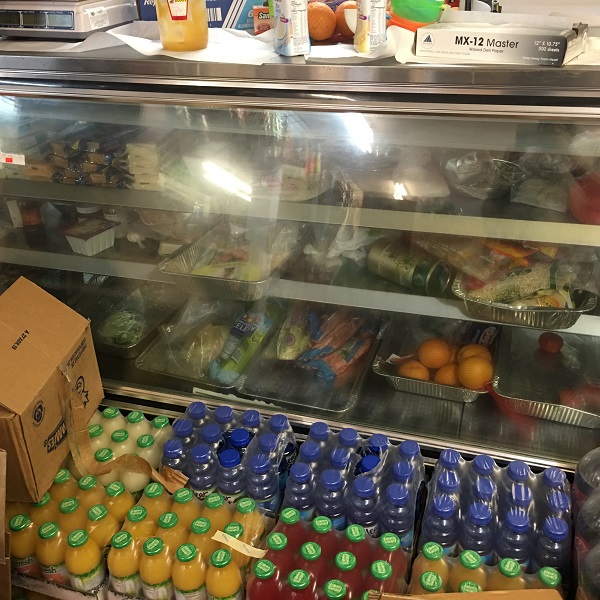
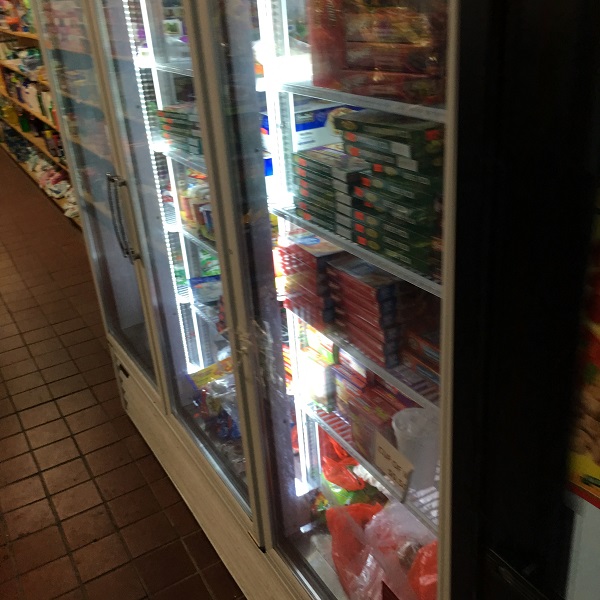
Block after block nothing changed. In fact, it only got worse the closer I got to the low-income housing projects.
I currently have more produce in my refrigerator than most of the corner stores combined. How is this happening? How is this the reality when not too far from here children grow up without food insecurity and have the privilege of shopping at upscale grocery stores like Whole Foods Market?
Can you imagine for a minute—should you find yourself privileged enough to not be in the situation being described—walking into your local grocery store and your produce options there being comparable to what you might find at a gas station?
Children in these systematically underserved communities grow up never knowing what butternut squash is, or what an artichoke tastes like. I wasn’t sure what I’d see during my tour, but what I found was injustice.
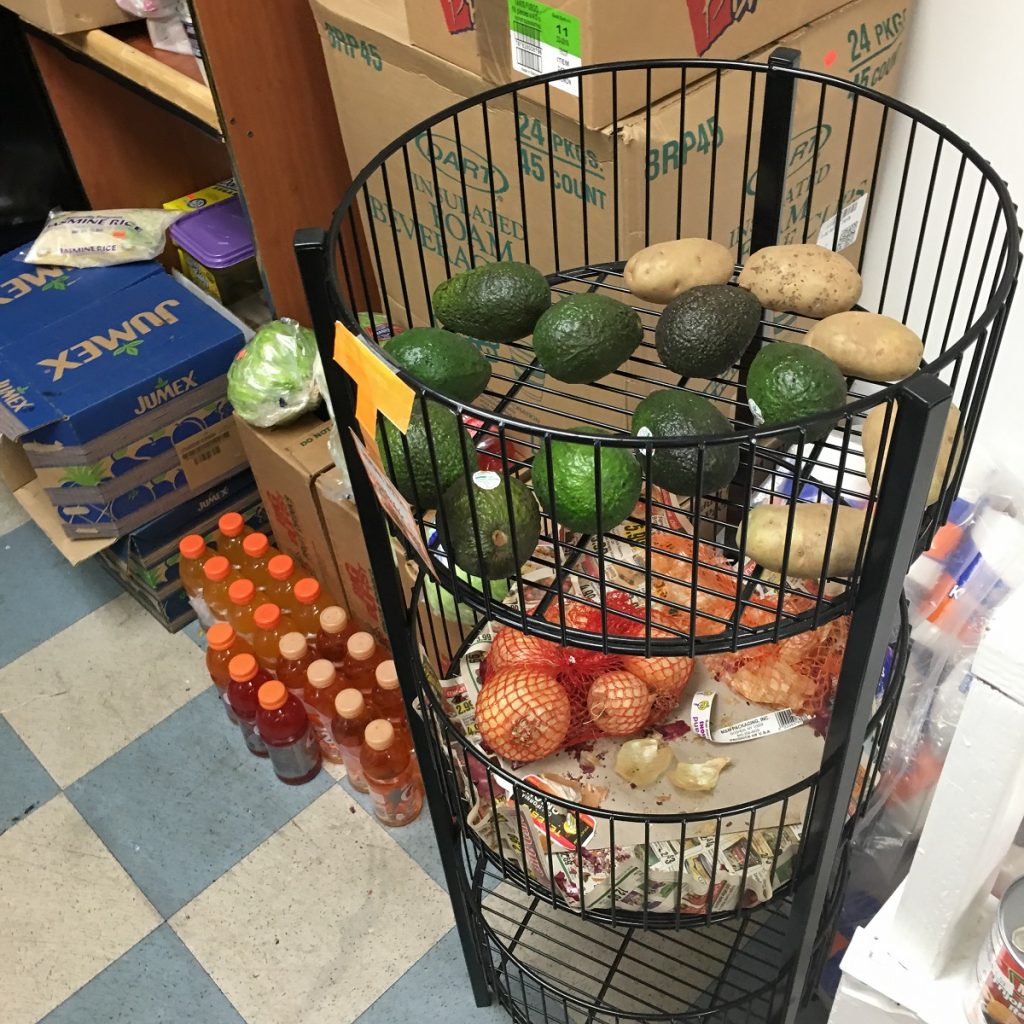
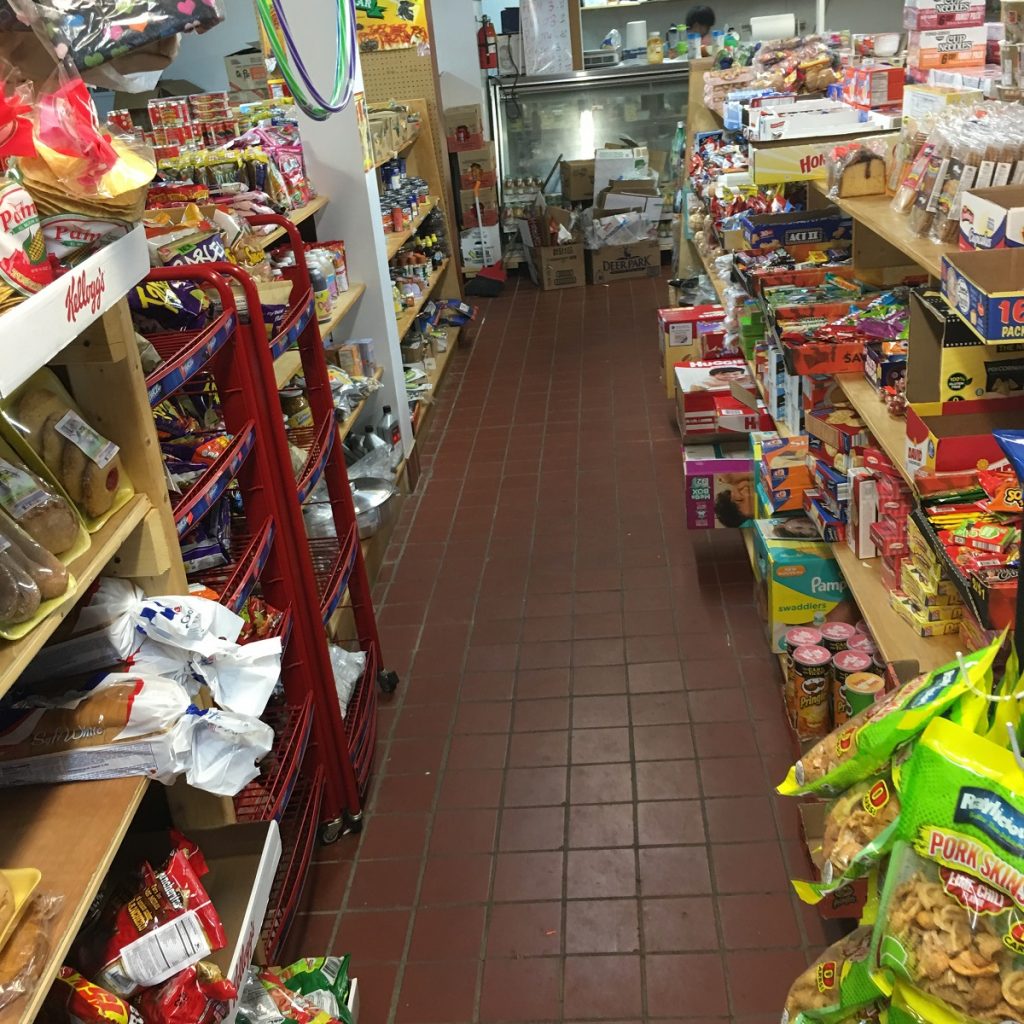
When Saturday rolled around and Paige and I arrived at Vegan SoulFest, it was a sight for sore eyes. Seeing every color under the sun being represented harmoniously at one beautiful festival was unbelievably restorative for me.
Seeing a community with all the odds stacked against them still rise reminds me of a beautiful proverb I recently read—“They tried to bury us but they didn’t know we were seeds.”
The Vegan SoulFest exemplifies the resiliency that lies within all oppressed people. It’s the desire for empowerment, fellowship, and knowledge—it’s community.
I cannot thank enough Brenda Sanders and Naijha Wright-Brown—the Vegan SoulFest co-founders and co-organizers—for seeing a need in their community and having the hearts to put this life-changing and life-saving festival together. We were truly blessed by what took place at Vegan SoulFest. The spirit of those two phenomenal women is why Baltimore is beautiful.
By Jamila Alfred, VO Maryland/DC Events and Outreach Coordinator
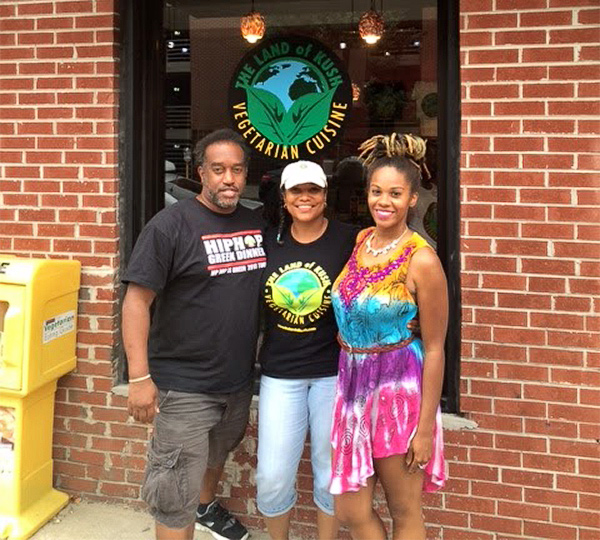
Last week I had the pleasure of meeting with Baltimore, Maryland power couple Naijha Wright-Brown and Gregory Brown, owners of the scrumptious vegan soul food restaurant The Land of Kush.
Located conveniently near the highway, this restaurant attracts more than hungry vegans looking for a yummy fix—it also brings in curious foodies and those who appreciate the taste of Southern cooking done right. Needless to say, this place has something for everybody!
When I lived in Baltimore last year, I’d always stop by The Land of Kush before class to grab a juice and then again afterwards for dinner. I can confidently say that the food, along with the laid-back, Afro-futuristic atmosphere, kept me coming back for more.
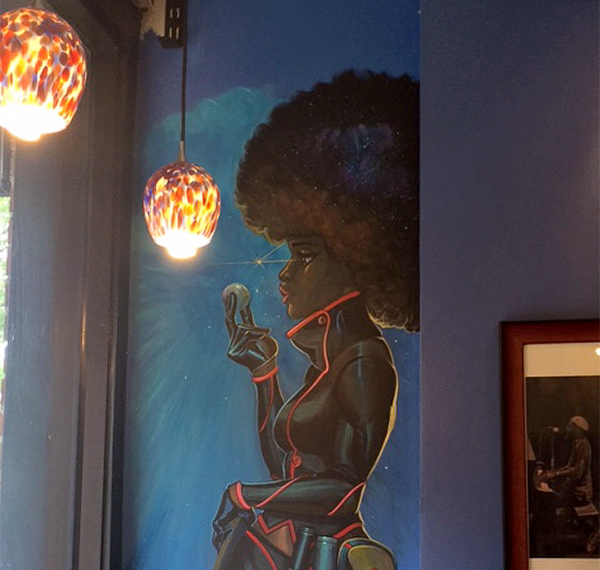
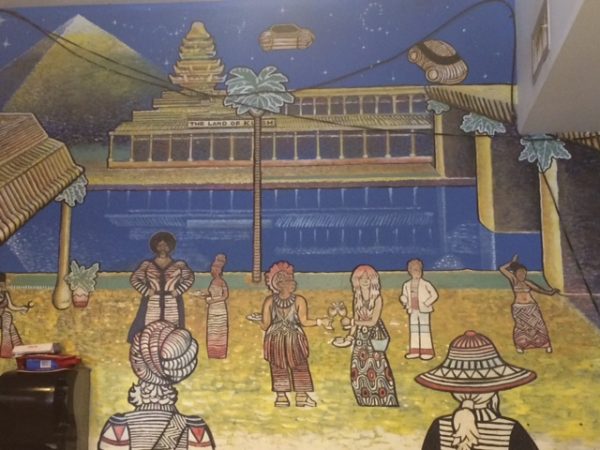
I was also very impressed with their choice of staffing, which consists mostly of Black, inner-city youth. This creates wonderful community support and helps keep Black businesses alive and thriving.
Naijha and Gregory are an absolute delight! Who’d have known that such busy people could be so down-to-earth? Their stories aren’t only entertaining, but also inspirational. Let’s get to know them!
Jamila Alfred: Where did you grow up?
Naijha Wright-Brown: South Bronx, New York.
Gregory Brown: Baltimore, Maryland.
Jamila: What are your professional backgrounds?
Naijha: Well, I’ve been working since I was 14, with several years of customer-facing, administrative and technical work, management, entrepreneurship, and putting together shows—whether it be comedy or talent shows. I also did some acting in my late 20s!
Gregory: I went to Morgan State University in Baltimore and graduated with an accounting degree. I used to work for MCI and Verizon Wireless, and now I own a restaurant.
Jamila: What do you do for fun?
Naijha: We love swimming, bike riding, going to comedy shows. I’ve loved comedy ever since I saw Chris Rock. I love to travel! Before we opened up, I was traveling a lot—about four times a year. About a week away wherever I went.
Gregory: Yeah, those are common interests for me, too.
Jamila: When and why did you go vegan?
Naijha: I went vegan in 2006, but I was fully into the game in 2008 because I was doing the fish thing before 2008. My journey started through health. I had high cholesterol and I didn’t know anything about veganism or vegetarianism.
Before I met Greg, I researched ways to lower cholesterol. Then when I met him where we both worked he would bring in these exotic dishes. That’s how I started getting educated on the vegan lifestyle. The whole movement with the animal rights and stuff, I didn’t get into that or learn about that until we opened The Land of Kush in 2011 or 2012.
Gregory: So I’ve been vegan since ’98, and got into it for the health reasons. I used to listen to the rapper KRS-One and he always talked about a vegetarian diet. That’s the route I took.
Jamila: What organizations are you involved in?
Naijha: I’m actually a reading partner for Reading Partners, so I help elementary school children with their reading. During the school year, I’m assigned a student and I help them read. I am also involved in the Black Vegetarian Society of Maryland (BVSMD)!
Gregory: I sit on the board of Farm Alliance of Baltimore—it helps urban farmers kind of put stuff together and sell their produce collectively at farmers markets.
I also sit on the board of the Visit Baltimore Education & Training Foundation—that’s basically an organization that gives scholarships to Baltimore city youth in the hospitality industry, so whether it’s culinary or working with hotels or the convention center. It gives them scholarships to get degrees and work experience. I am also involved with the BVSMD.
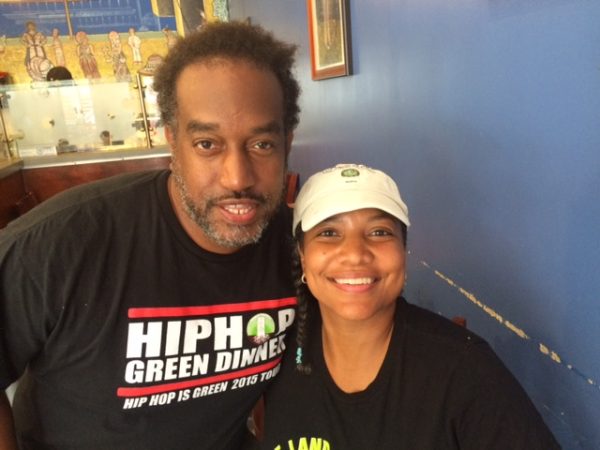
Jamila: Do you organize events in Baltimore?
Naijha: I co-founded Vegan SoulFest and we are now in our third year! It’s a vegan soul food festival. We say that because we have a lot of Black vegans and ethnic vegans in the area, so we wanted to reach out to that market and create a festival for them.
We’ve also helped with the Hip Hop Is Green Dinners. We’ve thought about venturing out on our own and doing some meatless meal dinners—anything that is going to reach and bring the community in to try plant-based food and teach them about the benefits of veganism.
Jamila: How was The Land of Kush born?
Gregory: I was working for MCI and I didn’t like working there because I wasn’t using my degree. Someone asked me to write down all of my questions to God, listen for answers, and then write the answers down. I wrote down that I wanted to own a restaurant. I was going vegan at the time, so I was like, “Why not a vegan restaurant?”
Then I began the journey of trying to get the restaurant open when, lo and behold, a friend asked me to find a vegetarian vendor for her company’s free jazz festival called Jazzy Summer Nights.
When I asked a couple of people that owned restaurants they were like, “Naww—there’s too many Black people out there at the festival. They don’t like vegetarian food. You’re not going to make any money.”
But I went back to my friend and told her I’d do it. I sold out of food at the festival, but I didn’t really make a profit because I didn’t know what I was doing.
I went to work for Verizon Wireless so I could recoup my money. I met my lovely wife there and we served food at a couple of events together. We served food at the African American Festival in Baltimore in 2008, Artscape in 2009, and then we opened up the restaurant. I left Verizon Wireless in 2010 and we opened up the The Land of Kush in 2011.
Naijha: I was interested in the The Land of Kush once Gregory introduced the idea to me. I had come to Baltimore from New York and I was always involved with something in New York, like talent shows or anything dealing with producing and promoting things.
I didn’t know anybody in Baltimore outside of the folks that transitioned with me through work. When Gregory proposed the idea of what he was trying to do, I wanted to help him because it seemed like something new and different. It was really exciting because I was just getting into the vegan lifestyle. I contributed to the website and the menu.
People were loving the food. The numbers started going up month after month. Then I was thinking, “What’s next?” I’m always in that producing mode!
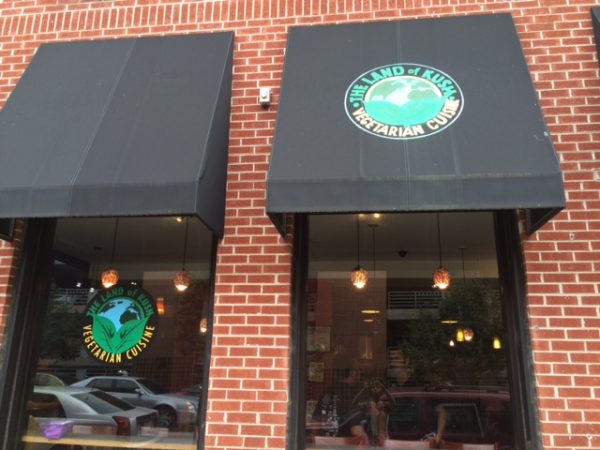
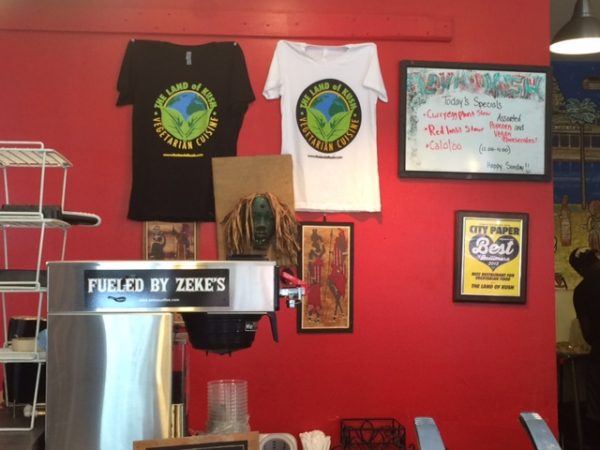
Jamila: Tell me about your experiences as Black business owners.
Naijha: It’s an experience! Being in customer service for Verizon Wireless and actually the quality assurance aspect of it—I’m talking about consumers, corporate, and government—I understand the importance as a Black business with customer service.
The stigma perceived by some customers who patronize Black businesses is that you’re going to a Black business and the service isn’t going to be up to par, so that’s a constant focus. When we’re bringing in employees, we ingrain that into them—that is, the importance of service to our customers. A lot of them are from the community and it might be their first job. They’re not used to customer-facing. We have to teach them all of that and the importance of being a Black business and delivering that.
It’s also relationship-building. It’s not like you’re waiting for people to come in. We actually spend a lot of time going out, whether it’s to corporations, or companies, or tastings. We find out what to do out there and how we could assist. We’re so little, so we can’t help everybody, but we try to collaborate with people to see what they need from us.
Gregory: It’s not just a business—it’s social outreach as well. Obviously we conduct a business for profits and to further our lives and create wealth and an opportunity for ourselves, but it’s also an opportunity to go out into the community and educate Black youth about veganism. That is something, a lot of times, that’s somewhat foreign to them. Going out teaching, doing cooking demos, teaching them about produce and fruits and vegetables, and things like that. It’s just a part of the cause for us.
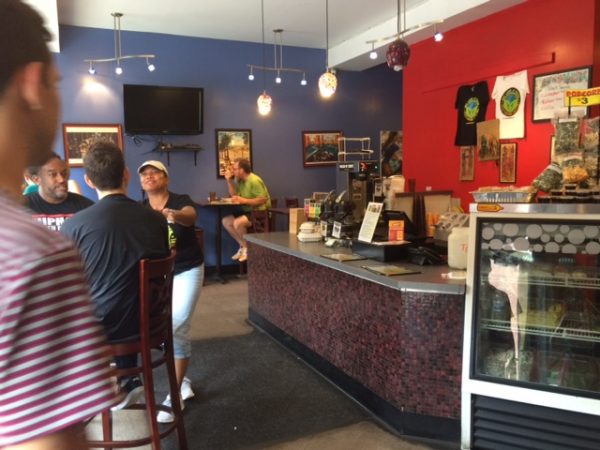
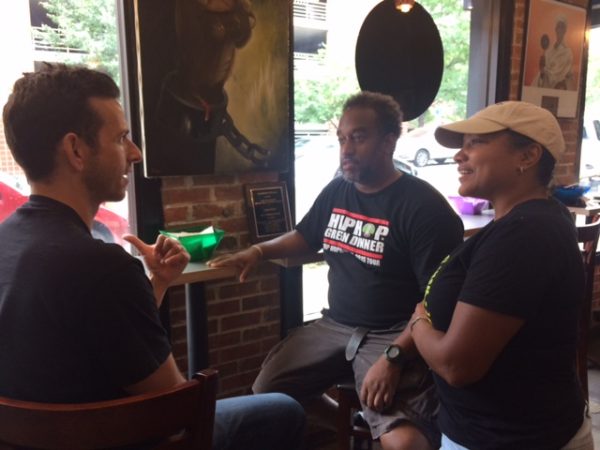
Jamila: What advice do you have for young people of color who want to start a business or get more into vegan advocacy?
Naijha: Disregard the naysayers and what they think. People are going to laugh about a lot of things. Gregory’s family even laughed about him wanting to open up the restaurant. But do it anyways—disregard the naysayers and take the risk—because there’s nothing better than the experience. In order to succeed you have to fail, but failing is learning so you can move on to the next level.
Gregory: Set a goal for yourself, you know? Have a vision for yourself and work towards it. Don’t be afraid of the obstacles. A lot of people stop because they’re afraid of what might happen and it’s okay to run into obstacles. Go run into them so that you can learn about them and overcome them.
Jamila: What future projects do you have?
Naijha: BVSMD is in its infancy. The first thing we did was the Hip Hop Is Green Dinner at Northwestern High School in Baltimore where we served over 200 individuals at that dinner. We used entertainment and lectures and we want to do more of that coming into 2017.
We also want to bring veganic wine and beer, entertainment, semi-fine dining, and carry-out to our business. [Veganic being a word combination of vegan and organic meaning organic plants farmed without the use of animal products or by-products.]
Gregory: The other thing we wanted to do is look for a second location for the The Land of Kush—so we want to franchise and look into those options. We want to expand the The Land of Kush because we’ve done well and want to spread that hopefully across the country.
Jamila: Thank you for taking the time to talk with me, Naijha and Gregory! And readers, if you ever find yourself in or near Baltimore, make sure you stop in and say hello to the folks at The Land of Kush. VO wishes the best of luck to the dynamic duo in the future!
By Lori Stultz, VO Rocky Mountain Outreach Coordinator

Looking for a friendly, upbeat vegan cookbook to inspire you in the kitchen?
Look no further!
The Friendly Vegan Cookbook is a new e-book packed with 14 delicious plant-powered recipes to get you cooking up a storm! Recipes include—
…and so much more.
The book—by our very own Vegan Outreach Social Media Manager, Michelle Cehn, and former VO Food and Lifestyle Coordinator, Toni Okamoto—features their favorite recipes along with their vibrant food photography.
The best part—40% of all proceeds benefit Vegan Outreach! Just make sure you use the link we’ve included in this post!
______________________________
We couldn’t contain our excitement about this e-book, so we’ve decided to give you a taste!
The following recipe, Garlicky-Ginger Tofu Triangles, is for tofu fans and non-tofu fans alike! We promise—even the most skeptical meat-eating friends of yours will love these flavorful tofu triangles!
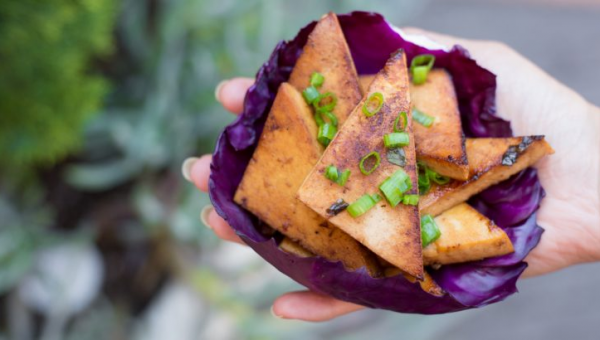
Garlicky-Ginger Tofu Triangles
Serves about 4.
Ingredients
Directions